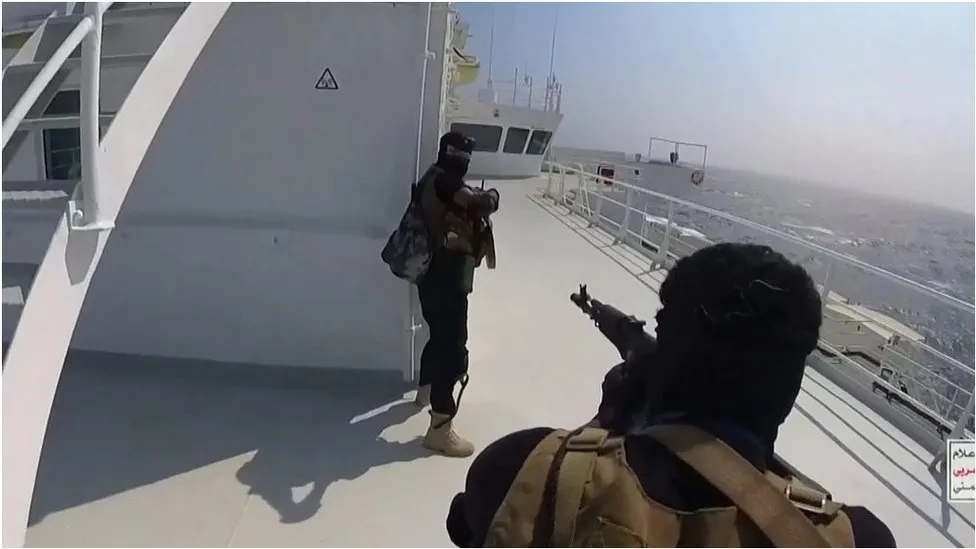On January 13th, the US military carried out an airstrike on a Houthi-controlled site in Yemen, citing its threat to commercial vessels in the Red Sea. The action followed a series of airstrikes launched by the US and Britain on January 12th, targeting Houthi rebels. The initial day of strikes, which occurred on January 12th, targeted 20 locations, hitting over 60 targets.
President Joe Biden had issued a warning on the same day, indicating the possibility of additional strikes against the Houthi forces.
Following the initial airstrikes, the most recent military strike occurred after a caution from the US Navy, advising American-flagged vessels to avoid regions around Yemen in the Red Sea and the Gulf of Aden for the next 72 hours. This warning coincided with a declaration from Yemen’s Houthis, pledging intense retaliation, thereby heightening the likelihood of an expanded conflict in a region already grappling with Israel’s conflict in Gaza.
Both the US military and White House officials expressed anticipation of retaliatory efforts from the Houthis.
Why have Houthis attacked Red Sea ships?
The Houthis initiated attacks on ships in the Red Sea shortly after the commencement of the conflict between Israel and Hamas on October 7th. Their pledge to retaliate comes as tensions escalate. The rebel group claims these attacks are aimed at exerting pressure on Israel to halt its intense bombardment of Gaza. This ongoing exchange of hostilities is heightening concerns that the conflict could extend further throughout the Middle East.
Subsequently, numerous commercial vessels have been attacked by drones and ballistic missiles, though it remains uncertain if all these vessels were enroute to Israel.
The frequency of these attacks escalated significantly between November and December.
In response to the ongoing assaults by Yemen’s Houthis on vessels navigating through the busy waterway, Maersk, the container shipping giant, recently declared its decision to redirect all vessels around Africa instead of utilizing the Red Sea and the Suez Canal for the “foreseeable future.”
The Danish company further mentioned: “We have therefore decided that the Maersk vessels due to transit the Red Sea/ Gulf of Aden will be diverted south around the Cape of Good Hope for the foreseeable future.”
“The situation is constantly evolving and remains highly volatile, and all available intelligence at hand confirms that the security risk continues to be at a significantly elevated level.”
The detour around Africa can extend journey times by approximately 10 days, necessitating additional fuel and crew time and consequently raising shipping costs. There is a growing concern that this could lead to an increase in fuel prices and disruptions in supply chains. The Red Sea, connected to the Mediterranean via the Suez Canal, serves as the shortest shipping route between Europe and Asia, with nearly 15% of global seaborne trade passing through this vital maritime corridor.
Who are Houthis?
The Houthis, also recognized as Ansar Allah or Supporters of God constitute an armed faction with control over significant portions of Yemen, including the capital city, Sanaa, and various areas near Saudi Arabia. Emerging in the 1990s, the Houthis gained prominence in 2014 when they rebelled against the Yemeni government, leading to its resignation and triggering a severe humanitarian crisis.
Subsequently, with the support of Iran, the group engaged in years of conflict against a military coalition primarily led by Saudi Arabia. Despite the ongoing hostilities, both factions have made repeated efforts to initiate peace talks. Around the turn of the century, the Houthis garnered backing from discontented Shia Yemenis who were disillusioned by the pervasive corruption and brutality of Ali Abdullah Saleh, the longstanding authoritarian president and ally of Saudi Arabia.
Further, intensified notably in the aftermath of 9/11 and the US invasion of Iraq. Amidst popular protests and multiple assassination attempts, Saleh eventually resigned in 2012.
In 2014, the Houthis allied with their previous adversary, Saleh, to capture the capital, Sana’a. A year later, they ousted the newly western-backed president, Abd Rabbu Mansour Hadi. Following Hadi’s displacement, the exiled Yemeni government sought military assistance from its allies in Saudi Arabia and the UAE. Supported by Western nations, a military campaign was launched to expel the Houthis from power.
Following a catastrophic civil war, the United Nations estimated that by the end of 2021, the conflict had resulted in 377,000 deaths and the displacement of 4 million people. Effectively, the Houthis emerged as the victors in the war. The introduction of a ceasefire in April 2022 led to a substantial reduction in violence, and despite the official expiration of the truce in October, hostilities have predominantly remained subdued.
International Reaction
The UN announced in late December that serious progress was made in negotiations, but experts warned that Houthis activity in the Red Sea could derail a final deal. They explained that attacks could trigger a US military response that could in turn “unravel the fragile ceasefire conditions.”
The spokesperson, Stephane Dujarric, conveyed that United Nations Secretary-General Antonio Guterres has urged all parties involved to refrain from escalating the precarious situation in the Red Sea.
“The Secretary General further calls on all parties involved not to escalate even more the situation in the interest of peace and stability in the Red Sea and the wider region.”
Nations such as Iran and Russia have condemned the US military strikes, stating that these attacks violate international laws.

